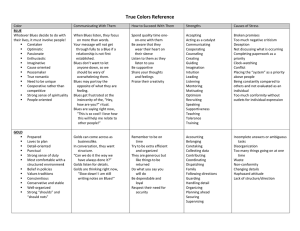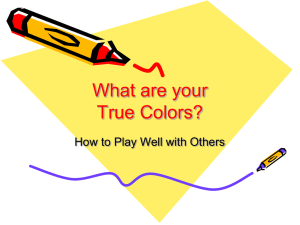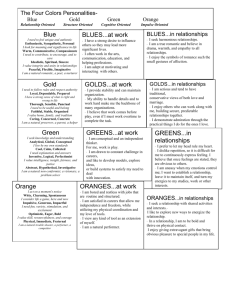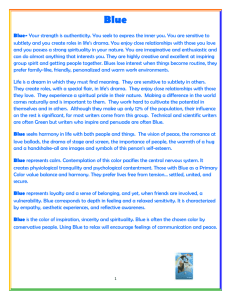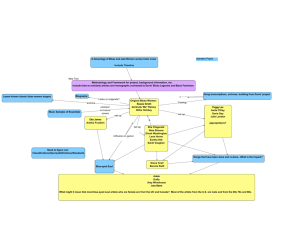The Results • A, H, K, N, S = ORANGE
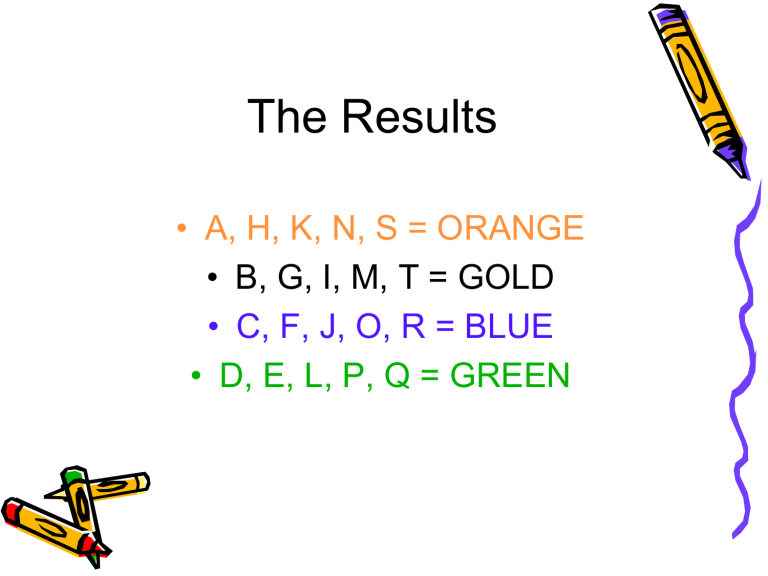
The Results
• A, H, K, N, S = ORANGE
• B, G, I, M, T = GOLD
• C, F, J, O, R = BLUE
• D, E, L, P, Q = GREEN
BLUE
Whatever Blues decide to do with their lives, it must involve people!
• Caretaker
• Optimistic
• Passionate
• Enthusiastic
• Imaginative
• Cause oriented
• Peacemaker
• True romantic
• Need to be unique
• Cooperative rather than competitive
• Strong sense of spirituality
• People oriented
Blue Strengths
Accepting
Acting as a catalyst
Communicating
Cooperating
Counseling
Creating
Guiding
Imagination
Intuition
Leading
Listening
Mentoring
Motivating
Optimism
Recruiting
Speaking
Supportiveness
Teaching
Tolerance
Training
Communicating with the Blue
• When Blues listen, they focus on more than words.
• Your message will not get through fully to a
Blue if a relationship is not first established.
• Blues don ’ t want to let anyone down, so we should be wary of overwhelming them.
• Blues may portray the opposite of what they are feeling.
• Blues get frustrated at the insincerity of the,
“ Hey, how are you?
” ritual.
• Blues are saying right now, “ This is so cool! I love how this will help me relate to other people!
”
The World vs. Blue
Creating STRESS for Blues…
Broken promises
Too much negative criticism
Deception
Not discussing what is occurring
Completing paperwork as a priority
Clock-watching
Conflict
Placing the “ system ” as a priority above people
Being constantly compared to others and not evaluated as an individual
Too much conformity without outlets for individual expression
Succeeding with the Blues…
- Spend quality time one-on-one with them
- Be aware that they wear their heart on their sleeve
- Listen to them as they listen to you
- Be supportive
- Share your thoughts and feelings
- Praise their creativity
Good as
Gold
• Prepared
• Loves to plan
• Detail-oriented
• Punctual
• Strong sense of duty
• Most comfortable with a structured environment
• Belief in policies
• Values traditions
• Conscientious
• Conservative and stable
• Well-organized
• Strong “ shoulds ” and
“ should nots ”
Gold Strengths
Accounting
Belonging
Caretaking
Collecting data
Contributing
Coordinating
Dispatching
Family
Following directions
Guarding
Handling detail
Organizing
Planning ahead
Securing
Supervising
Communicating with Golds
• Golds can come across as businesslike.
• In conversation, they want structure.
• “ Can we do it the way we have always done it?
”
• Golds listen for details.
• Golds are thinking right now, “ Slow down! I am still writing notes on
Blues!
”
The World vs. Gold
Creating stress for Golds…
Succeeding with Golds…
Incomplete answers or ambiguous tasks Remember to be on
Disorganization time
Too many things going on at one time
Try to be extra efficient and organized
Waste
Non-conformity
Changing details
They are generous but like things to be returned
Haphazard attitude
Lack of structure/direction
Do what you say you will do
Be dependable and loyal
Respect their need for security
Just do it! ORANGE
• Extroverted Orange:
Tigger (everyone knows when he is around and very little stresses him out)
• Introverted Orange:
Winnie the Pooh (goes with the flow and only major concern is HONEY!)
OUTRAGEOUS ORANGE
• Energetic
• Desires change
• Playful
• Master navigator
• Natural entertainer
• Pushes boundaries
• Accepts challenges
• Impulsive
• Spontaneous
• “ Just do it!
”
• Appreciates immediate feedback
• Most productive in nonstructure environments
Able to take charge
Being the master of tools
Carefree
Dealing with chaos
Determination
Direct communicator
Doing many things at once
Eclectic, diverse, changing
Orange Strengths
Going with the situation
Hands-on
Keeping options open
Negotiating
Proficient, capable
Receptive to opportunities
Risk-taking
Trouble-shooting
Welcomes new ideas
Communicating with
Oranges
• Oranges are confident, loud, and casual
• “ Now ” oriented
• Oranges listen for usefulness, and relevance
• They are constantly opportunities
• They want forthright communication
• They are trying to accomplish a goal with all communication
• When talking to an
Orange, encapsulate your information into bite-size pieces
• Give Oranges choices and ask for their suggestions
The World vs. Orange
Creating Stress for Oranges…
- Too much responsibility
- Redundancy
- Deadlines
- Rules and regulations
- Being stuck at a desk
“ how to ” directions
- Too much attention to product and not enough to performance/results
- Abstract concepts
Succeeding with the Orange…
- Be active and don ’ t slow them down!
- Be spontaneous and fun
- Compete in fun when appropriate
- Be adventuresome and optimistic
- Be energetic and ready to go!
Feelin ’ Green
• Problem-solver
• “ Why ” mentality
• Very complex
• Standard-setter
• Cool, calm, collected
• Approaches interpersonal relationships in a logical manner
• Intellectual
• Work is play and play is work
• Need for independence and private time
• Driven by competence
• Perfectionist
• Analytical
Green Strengths
Analyzing
Conceptualizing
Confidence
Designing
Determination
Developing
Diagnosing
Intellectualization
Inventing
Mapping out
Problem solving
Reasoning
Researching
Technical know-how
Thinking
Communicating with Greens
• Greens communicate for the purpose of gaining or sharing information.
• Their favorite line is,
“ And your point is?
”
• Greens listen for information and want to know the purpose for that particular communication.
• Greens usually don ’ t show emotion.
• When talking to a
Green, be prepared to defend your position!
• Greens are thinking now,
“ How will this help me with people, again? I don ’ t need help with people. Why would I?
”
The World vs. Greens
Creating stress for Greens…
Not being in charge
Lack of independence
Elaborate use of adjectives
Incompetence
Emotional displays
Lack of options
Inability to use or display knowledge
Small talk
Routine
Social functions
Succeeding with Greens…
Be aware of their curiosity about life
Give things that challenge their problem-solving abilities
Respect their need for independence
Know that they are caring even though they may not show their feelings much
Respect their ideas
Why is this important?
• “ It ’ s easy to get the players. Getting them to play together, that ’ s the hard part ” (Baseball legend Casey Stengel).
• We must understand in order to be understood
(Stephen Covey).
Why True Colors?
• “ Color ” watching is only one filter through which to view human behavior.
• True colors should alter your interactions as you become more aware.
• It helps you understand values, needs, and actions of others.
• True Colors is not supposed to provide you with one strategy for changing yourself or others but to help you understand more fully behaviors and people.
• Learning the True Color language and customs of others not only lowers tension and resistance levels, but it also demonstrates the utmost respect
. It helps you build relationships and collaboration.
Some inspiration…
“ Coming together is a beginning; keeping together is progress; working together is success.
”
- Henry Ford
